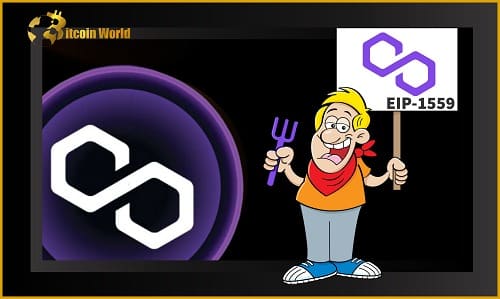Hold onto your MATIC! Big news from the Polygon network – they’ve just rolled out EIP-1559, a game-changing upgrade that’s set to bring some serious heat to the ecosystem. Think of it as Polygon adopting a key feature from Ethereum’s highly anticipated ‘London Hardfork’. But what exactly does this mean for you, the Polygon user, investor, or crypto enthusiast? Let’s dive into the details and unpack this exciting development.
Polygon Adopts EIP-1559: Burning MATIC Tokens in Real-Time
Just recently, at 2:48 a.m. UTC to be precise, Polygon activated EIP-1559 at block height 23850000. This isn’t just a minor tweak; it’s a fundamental shift in how transaction fees work on the Polygon network. Say goodbye to the old “first-price auction” system! Polygon is stepping into a new era with this upgrade, often referred to as the ‘London Hardfork’ due to its Ethereum origins.
So, what’s the big deal about EIP-1559?
- Predictable Gas Fees: Instead of the unpredictable auction system, Polygon transactions will now operate with a ‘base fee’. This base fee is an estimated cost required for your transaction to be included in the upcoming blocks. Think of it as a more transparent and stable way to understand transaction costs.
- Stability During Peak Demand: EIP-1559 is designed to make the network fee system more stable, especially when things get busy. The protocol intelligently adjusts the base fee up or down based on network congestion. This dynamic adjustment is crucial for maintaining a smooth user experience even during peak times.
- User-Friendly Wallets: For those using Web3 wallets, EIP-1559 brings consistency and reliability to gas fee estimations. Wallets can now provide more accurate and dependable gas fee suggestions to users, removing a layer of guesswork and potential frustration.
Essentially, EIP-1559 is about making the Polygon network more efficient, user-friendly, and robust.
EIP-1559: Burning MATIC and Rewarding Validators
Here’s where things get really interesting. EIP-1559 isn’t just about smoother fees; it introduces a token burning mechanism!
With EIP-1559, a portion of each transaction fee, specifically the ‘base fee’, is burned in MATIC tokens. Instead of validators receiving the entire transaction fee as in the previous system, the base fee is effectively removed from circulation. But don’t worry, validators still get rewarded!
The Priority Fee: Incentivizing Faster Transactions
To ensure transactions are processed quickly, EIP-1559 also introduces a “priority charge” (sometimes called a ‘tip’). This priority fee acts as an incentive for validators to prioritize certain transactions. If you’re in a hurry and need your transaction processed faster, you can add a priority fee to incentivize validators to include it sooner.
Think of it like this:
| Fee Component | Description | Destination |
|---|---|---|
| Base Fee | Minimum fee required for transaction inclusion. Dynamically adjusts based on network congestion. | Burned (removed from MATIC supply) |
| Priority Fee (Tip) | Optional fee to incentivize faster transaction processing. User-defined. | Validators (as reward) |
Ethereum’s Blueprint: Learning from the London Hardfork
Polygon’s implementation of EIP-1559 is inspired by Ethereum’s successful adoption of the same upgrade in August of last year as part of their ‘London Hardfork’. Ethereum’s experience provides valuable insights into the potential benefits and impacts of this change.
One key outcome Ethereum observed with EIP-1559 was a reduction in spam transactions and overall network congestion. Polygon anticipates similar positive effects on its network, leading to a smoother and more efficient experience for everyone.
The Deflationary Impact on MATIC: Less Supply, Potentially Higher Value?
Beyond gas fee predictability, Ethereum’s EIP-1559 had a significant impact on ETH’s monetary policy. The burning mechanism has demonstrably reduced the circulating supply of Ether. This brings us to a crucial point for MATIC holders: could EIP-1559 have a deflationary effect on MATIC?
The Polygon team believes so. With MATIC having a fixed total supply of 10 billion tokens, burning a portion of the supply can indeed lead to deflationary pressure. Their analysis predicts that EIP-1559 could burn approximately 0.27% of the total MATIC supply annually. While this might seem like a small percentage, over time, it can accumulate and potentially impact MATIC’s value by reducing its overall availability.
What Does This Mean for MATIC Holders and Polygon Users?
In a nutshell, Polygon’s EIP-1559 implementation is largely seen as a positive development for the network and its users. Here’s a quick summary of the key takeaways:
- More Predictable Transaction Fees: Say goodbye to wild gas fee fluctuations and hello to more stable and understandable costs.
- Reduced Network Congestion: EIP-1559 aims to curb spam transactions, potentially leading to a less congested and faster network.
- Potential Deflationary Pressure on MATIC: The token burning mechanism could reduce MATIC’s supply over time, potentially increasing its scarcity and value.
- Enhanced User Experience: Web3 wallets will be able to provide more accurate gas fee estimations, making transactions smoother and less confusing.
While the exact impact on MATIC’s price is subject to market dynamics and broader crypto trends, the implementation of EIP-1559 is a significant step towards a more robust and sustainable Polygon ecosystem. It reflects Polygon’s commitment to continuous improvement and its willingness to adopt successful strategies from Ethereum and beyond.
Keep an eye on the Polygon network and MATIC token – things are definitely heating up!
Related Posts – Ex-SEC Chair, Jay Clayton Believes Cryptocurrency Industry Is For Long Haul
Disclaimer: The information provided is not trading advice, Bitcoinworld.co.in holds no liability for any investments made based on the information provided on this page. We strongly recommend independent research and/or consultation with a qualified professional before making any investment decisions.


